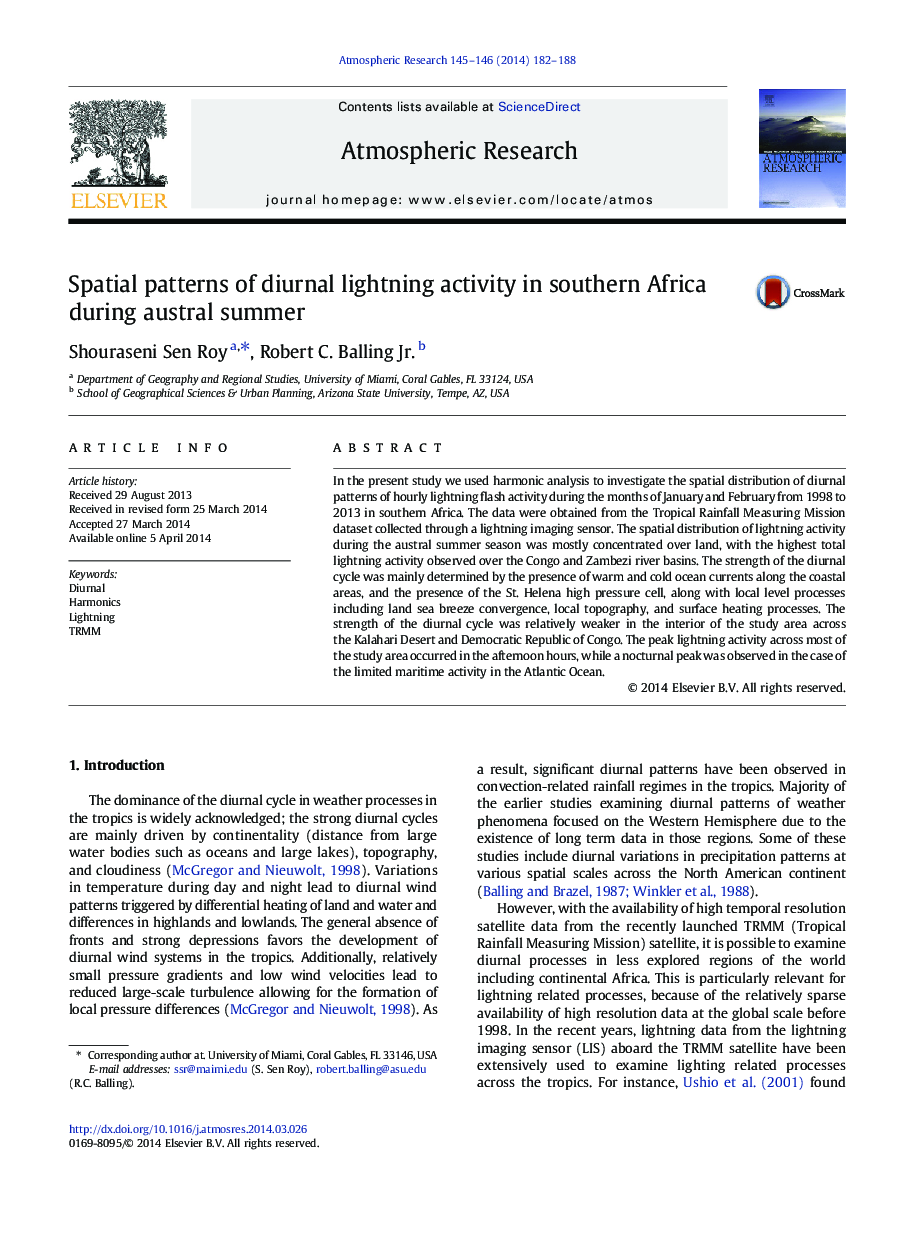| کد مقاله | کد نشریه | سال انتشار | مقاله انگلیسی | نسخه تمام متن |
|---|---|---|---|---|
| 6343569 | 1620526 | 2014 | 7 صفحه PDF | دانلود رایگان |
عنوان انگلیسی مقاله ISI
Spatial patterns of diurnal lightning activity in southern Africa during austral summer
ترجمه فارسی عنوان
الگوهای فضایی فعالیت روزانه رعد و برق در جنوب آفریقا در فصل تابستان
دانلود مقاله + سفارش ترجمه
دانلود مقاله ISI انگلیسی
رایگان برای ایرانیان
ترجمه چکیده
در مطالعه حاضر، از تحلیل هارمونیک برای بررسی توزیع فضایی الگوهای روزانه فعالیت فلش ساعتی در ماههای ژانویه و فوریه سالهای 1998 تا 2013 در جنوب آفریقا استفاده شد. داده ها از داده های مأموریت سنجش بارش بارش گرمسیری جمع آوری شده از طریق سنسور تصویربرداری رعد و برق به دست آمده است. توزیع فضایی فعالیت های رعد و برق در طول فصل تابستان شرقی عمدتا بر روی زمین متمرکز بود و بیشترین فعالیت رعد و برق در سراسر حوضه رودخانه کنگو و زامبی دیده می شود. قدرت چرخه روزانه عمدتا با حضور جریان های گرم و سرد اقیانوس در امتداد مناطق ساحلی و حضور سلول فشار بالا سنت هلنا همراه با فرآیندهای محلی شامل همگرایی نسیم دریایی دریایی، توپوگرافی محلی و فرایندهای حرارت سطح قدرت چرخه روزانه در داخل ناحیه مطالعه در کویر کالاهاری و جمهوری دموکراتیک کنگو نسبتا ضعیف بود. فعالیت های رعد و برق در بیشتر قسمت های مطالعه در ساعت های بعد از ظهر رخ داد، در حالی که در فعالیت های دریایی محدود در اقیانوس اطلس، اوج شبانه مشاهده شد.
موضوعات مرتبط
مهندسی و علوم پایه
علوم زمین و سیارات
علم هواشناسی
چکیده انگلیسی
In the present study we used harmonic analysis to investigate the spatial distribution of diurnal patterns of hourly lightning flash activity during the months of January and February from 1998 to 2013 in southern Africa. The data were obtained from the Tropical Rainfall Measuring Mission dataset collected through a lightning imaging sensor. The spatial distribution of lightning activity during the austral summer season was mostly concentrated over land, with the highest total lightning activity observed over the Congo and Zambezi river basins. The strength of the diurnal cycle was mainly determined by the presence of warm and cold ocean currents along the coastal areas, and the presence of the St. Helena high pressure cell, along with local level processes including land sea breeze convergence, local topography, and surface heating processes. The strength of the diurnal cycle was relatively weaker in the interior of the study area across the Kalahari Desert and Democratic Republic of Congo. The peak lightning activity across most of the study area occurred in the afternoon hours, while a nocturnal peak was observed in the case of the limited maritime activity in the Atlantic Ocean.
ناشر
Database: Elsevier - ScienceDirect (ساینس دایرکت)
Journal: Atmospheric Research - Volumes 145â146, AugustâSeptember 2014, Pages 182-188
Journal: Atmospheric Research - Volumes 145â146, AugustâSeptember 2014, Pages 182-188
نویسندگان
Shouraseni Sen Roy, Robert C. Jr.,
